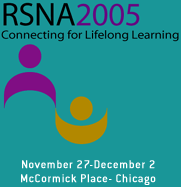
Abstract Archives of the RSNA, 2005
Christoph Weber MD, PhD, Presenter: Nothing to Disclose
Gerrit Krupski MD,PhD, Abstract Co-Author: Nothing to Disclose
Harald Ittrich MD, Abstract Co-Author: Nothing to Disclose
Ulrich Seitz MD, Abstract Co-Author: Nothing to Disclose
Xavier Rogiers, Abstract Co-Author: Nothing to Disclose
Gerhard Adam, Abstract Co-Author: Nothing to Disclose
To evaluate MR-Cholangiopancreaticography (MRCP) as a low risk alternative to Endoscopic Retrograde Cholangiopancreaticography (ERCP) in diagnosing primary sclerosing cholangitis (PSC) and to compare diagnostic accuracy of different T2 w sequences.
Ninety-five patients (59 males, 36 females; mean age 41 years, range 16 to 71 years) with suspected PSC were examined in a 1.5 T MR unit, using breath hold, coronal and transverse Half Fourier Acquisition Single Shot Turbo Spin Echo (HASTE), coronal-oblique, fat-suppressed half-Fourier rapid acquisition with relaxation enhancement (RARE) and coronal-oblique, fat-suppressed, multisection, thin-section HASTE (TS-HASTE) sequences. Morphologic criteria of PSC were systematically evaluated and correlated with the gold standard ERCP by two radiologists in a blinded random review in consensus.
MRCP was found to be accurate in detecting PSC and in defining the extent of disease. PSC was confirmed in 69 of 95 patients (ERCP 95 of 95, additional liver biopsy 40 of 95, brush biopsy 11 of 95). In the detection of PSC, sensitivity, specificity and diagnostic accuracy were 86%, 78% and 84% for the diagnostically superior RARE sequence. These results for the RARE sequence could be even raised to 93%, 78% and 91% respectively by including 79 follow-up examinations. HASTE and TS-HASTE showed significantly less diagnostic accuracy for the detection of PSC but were helpful for additional morphologic information on the presence of ascites, wall thickening and calculi etc. A scoring system was developed for determination of the presence or absence of PSC on the MR cholangiogram. Qualitative analysis of image quality showed no significant difference between RARE, HASTE and TS-HASTE sequences (3.4/3.5/3.5/3.2). A Klatskin tumor and a cholangiocellular carcinoma, which were misdiagnosed by MRCP, were diagnosed by brush biopsy in 2 of the 69 patients with confirmed PSC.
MRCP is proven as a reliable non invasive imaging method to diagnose and follow PSC. For a streamlined MRCP protocol the RARE sequence is mandatory while the HASTE sequences are additionally recommended.
Weber, C,
Krupski, G,
Ittrich, H,
Seitz, U,
Rogiers, X,
Adam, G,
MRCP in Primary Sclerosing Cholangitis: Comparison of Different Techniques with ERCP. Radiological Society of North America 2005 Scientific Assembly and Annual Meeting, November 27 - December 2, 2005 ,Chicago IL.
http://archive.rsna.org/2005/4414359.html

